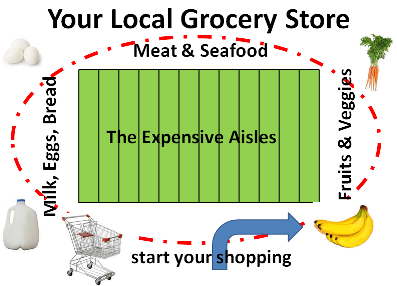
The average family of four, meanwhile, can expect to incur around $1000 worth of food expenses each month when following a similar middle-of-the-road strategy.
How does your family’s spending compare with how to save money on groceries? If you and your spouse have two children, do you fall above or below the $1000/month figure? If below, you can congratulate yourself on being efficient with your grocery purchases.
Of course, you can always strive to realize added cuts that can bring your spending into the low-cost range (around $800/month) and allow you to put more money into your online savings account. But, if over that mark, you might want to make a concerted and sustained effort to reduce your food budget, especially if money is tight. Doing so can amount to tremendous savings in the long-run.
With food prices on the rise and wages relatively stagnant so far for 2016, many families are looking for new ways to save money on their food budget. If you fall into this category, then read on to discover useful grocery hacks that will cut back your food budget at the grocery store.
Grocery Hacks To Trim Down Your Food Budget
Don’t Shop While You’re Hungry
You’ve probably heard the generic advice that you shouldn’t shop while you’re hungry, but did you know that there are actual neurobiological studies proving that shopping on an empty stomach makes you spend more money on groceries?
In this experiment, participants were either injected with ghrelin (a hormone that controls hunger) or saline (basically a placebo) and then they were asked to bid on both food and nonfood items in a lab. The participants with elevated hunger hormones were much more willing to spend more money on food, showing that humans are more prone to impulsive purchases in the grocery market when we’re hungry. To avoid this pitfall, either schedule your shopping trips after meals or eat a snack before you go.
Become a Couponing Ninja
Have you ever seen that TLC show, Extreme Couponers? Although the idea of getting tons of stuff for pennies may be alluring, it’s probably not worth all the hours of coupon clipping and discount hunting on the web.
However, you can still save quite a bit of money on groceries and everyday household items if you just add coupons to your shopping repertoire.
Here are some fantastic couponing websites to check out:
There are also handy couponing apps for smartphone-savvy shoppers who want to become couponing ninjas without having to go through paper ads every Sunday:
Stay On The Outside Loop
Like a race car driver, you should stay on the outside track of the grocery store and away from the middle. Not only will your wallet be appreciative, but your midsection will as well.
Think about it where are all the sugary, sweet treats? Where are the most expensive foods in the supermarket? Where are all the foods that are staples that you desperately need to feed your family? They are on the outside lanes of the store like a loop.
Don’t go down the middle isles if you can help it. The meat, milk, dairy, vegetables, and breads are all on the outside lane. Stay on the outside to save money. Don’t go down the aisle.
Never Forget Your Loyalty Car

I am always blown away by how many people tend to forget their loyalty card and miss out on tons of savings and coupons. Do not let it go if you do. Forgetting even just once can cost you a few dollars.
You should ask your fellow shoppers to your front and back to swipe theirs in a pinch. They get the credit for your purchases especially if they have linked their loyalty card to a program like uPromise to earn rewards and money for their children’s college education.
Sometimes you can ask the cashier to use their cards but many grocery chains frown upon this practice. In the worst case scenario, you should consider just signing up and grabbing a new card. You can always just throw it away, but it is better to have five cards from the same grocery chain than miss the savings.
Stay Away From Impulse Purchases
Originally, studies came out in the 1990s that said that almost 70% of all our purchases at the grocery store were impulse purchases. Now, a new study conducted by Professor David R. Bell from the Wharton School of Business has found that the number might be closer to 20%.
That’s a relief but still very troubling. My family may spend several hundred dollars to feed our family every month. So, over $50 could quite possibly be pure needless impulse purchases. It can really add up when you stop to put real numbers to your bad habits.
There are many ways that you can save money on your groceries. Most people only consider clipping coupons and hitting the weekly sales though. This is a mistake to only focus on those tactics. You also need to address your spending habits as well in order to save money at the grocery store.
Skip the Organic
According to Consumer Reports, the cost of organic food, on average, is 47% higher than conventional food. This doesn’t mean that organic food is always more expensive, but in many cases, your food budget would be better off with traditionally grown produce.
There are few nutritional differences between the two options and the Scientific American reported in its article, “Mythbusting 101: Organic Farming > Conventional Agriculture” that organic pesticides might be even worse than conventional agriculture pesticides.
The verdict? Save yourself the expense and opt out of organic produce.
Almost-Expired Food Discounts
Did you know that many stores offer steep discounts on perishable items when they’re about to expire? Whether it’s prepackaged mushrooms, chicken with a “Sell By” date within 1-2 days, or any number of perishable items, the store would rather unload them at a discount instead of throwing it in the garbage and getting nothing out of it (not to mention contributing the massive food waste problem in the US).
Shop at Discount Grocery Markets
Grocery discount chains such as Aldi and Grocery Outlet are currently expanding in the US. These discount grocers offer all types of quality food items, which they get from producers with excess inventory and then pass along the savings from the manufacturers to their customers. They even have vegan options. Here, you can shave tens – if not hundreds – of dollars each month on your grocery bill without having to change your buying habits.
Discount markets often have special coupons and offers for customers who sign up for email lists and “like” their local grocery stores on Facebook. If you do not have any discount grocers near you, then be sure to sign up for major grocery stores’ rewards programs so you can get member-only discounts and in some cases, even discounts on gas.
Switch to Canned or Frozen Produce
Another option for reducing your grocery bill while still managing to eat your daily recommended servings of fruits and vegetables is to buy canned or frozen produce. NPR reported in 2014 that the BPA content in canned food isn’t dangerous, which means there are few downsides to buying canned fruit and vegetables as an alternative to buying expensive, fresh produce that has a quickly approaching expiration date.
Frozen produce is also a viable option for someone with a cash-strapped grocery budget, and although people argue that it’s not as nutritious, it’s still preferable to forgoing fruits and vegetables altogether out of financial necessity.
Plan out meals beforehand
When we go to the grocery store we usually have a general conception of what we plan to eat over the next couple weeks, and we use that conception to writing a shopping list. This approach is certainly more effective than going to the store with no list in hand, but it still results in purchase inefficiencies.
In other words, we don’t actually need everything that we think we do. How can this be corrected? Plan your meals out beforehand – even two weeks out – and then go shopping with a determined meal plan in mind. This will ensure that you only buy those items that you know you need.
Buy non-perishables in bulk
Cereals, pasta, canned items, spices, and other major non-perishables can be gotten for much cheaper when bought in bulk. With this in mind, head out to Costco or Sam’s Club or a similar warehouse store whenever a bulk purchase needs to be made. Then, store any surplus in your pantry or basement until it is needed.
Use a store card. Many grocery store chains offer membership cards that provide regular discounts, rebates, and other promotions. While many consumers are hesitant to use these cards – possibly because retail store cards have a deservedly bad reputation – a membership at your local shopping place will almost always amount to savings in the long-run.
Go vegetarian
Since meat products are usually among the most costly in a grocery store and in a family’s shopping budget, the move towards vegetarianism can translate into substantial savings and allow you to save money on groceries. Instead of purchasing costly red meat or chicken, your family can instead get the same protein benefits from far cheaper items such as lentils and beans.
Seek out nutritional, low-cost foods
On a similar note, finding foods that have a high nutrition-to-cost ratio is a great way to feed your family without incurring much cost. These foods include beans, rice, pasta, tuna, and eggs, among others.
Buy store-brand
This one goes without saying, but store brand items are almost universally cheaper than private brand products – and they are rarely distinguishable when it comes to taste and quality.
These are a few ways that you can try to reduce your family’s grocery expenses. While a few savings here and there may not seem like much, they can amount to considerable budget reductions in the long run.
As you can see, there are many different ways to save money on groceries beyond the obvious advice of “buy in bulk” and “buy generic instead of brand name foods.” If you’re on a tight food budget, every dollar saved really matters, especially when the potential to waste food (and subsequently, money) is there.
What about you? Do you have any unique ways that you save money on your food budget and grocery bill?


